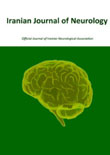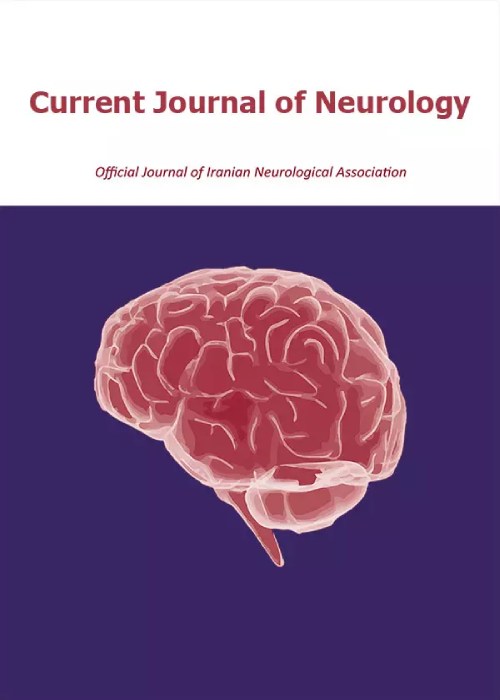فهرست مطالب

Current Journal of Neurology
Volume:15 Issue: 2, Spring 2016
- تاریخ انتشار: 1395/02/13
- تعداد عناوین: 11
-
-
Page 63BackgroundThe ketogenic diet (KD), high in fat and low in carbohydrate and protein, provides sufficient protein but insufficient carbohydrates for all the metabolic needs of the body. KD has been known as a therapeutic manner intractable epilepsy. In recent years, the effectiveness of KD drew attention to the treatment of some other disorders such as Parkinsons disease (PD). This study has evaluated the efficacy of KD on motor function in Parkinsonian model of rat and compared it with pramipexole.MethodsA total of 56 male Wistar rats weighing 200-240 g between 12 and 14 weeks of age were randomized in seven 8-rat groups as follows: Control group; sham-operated group; KD group; Parkinsonian control group; KD-Parkinsonian group; pramipexole-Parkinsonian group; and KD-pramipexole-Parkinsonian group. The results of bar test, beam traversal task test, and cylinder task test were compared between the groups.ResultsThe mean number of ketone bodies had increased significantly in the rats blood after KD. Regarding the results of the triad tests, no statistically significant difference was found between the controls and the sham-operated group. Among the Parkinsonian rats, better results were found in KD groups compared to the non-KD group. The KD enhanced the effect of pramipexole for motor function but did not reach a statistically significant level.ConclusionThe KD reinforced the motor function in Parkinsonian rats in our study. When the diet was combined with pramipexole, the effectiveness of the drug increased in enhancing motor function.Keywords: Parkinson's Disease, Pramipexole, Ketogenic Diet
-
Page 70BackgroundCarpal tunnel syndrome (CTS) is a common peripheral entrapment neuropathy in patients with hypothyroid. The diagnosis of CTS is usually clinical and confirmed by electrodiagnostic (EDX) procedures. This study aimed to describe the diagnostic accuracy of high-resolution ultrasonography (US) as an alternative method to nerve conduction study (NCS) for the diagnosis of subclinical CTS in patients with hypothyroidism.MethodsBetween April 2013 and November 2014, from the patients with the diagnosis of hypothyroidism referring to the institute of endocrinology and metabolism of Firoozgar Hospital, Tehran, Iran, those who met our inclusion criteria entered this cross-sectional study. The patients divided into two groups of subclinical CTS with the age- and gender-matched control group. US measurements of the median nerve cross-sectional area (CSA) in the CT inlet were compared with the NCS results as the gold standard diagnostic test.ResultsA total number of 152 wrists of 76 hypothyroid patients were examined in this study. The mean of median nerve CSA at the tunnel inlet was 9.96 ± 2.20 mm2 for the CTS group and 7.08 ± 1.38 mm2 for the control group (PConclusionAccording to our findings, US has an acceptable diagnostic value to confirm CTS in hypothyroid patients. However, it may not replace NCS due to low sensitivity.Keywords: Carpal Tunnel Syndrome, Ultrasonography, Hypothyroidism
-
Page 75BackgroundEvidence is accumulating that venous thromboembolism is not limited to coagulation system and immune system seems to be involved in formation and resolution of thrombus. Some studies have demonstrated the role of inflammatory factors in deep venous thrombosis (DVT) of limbs; however, there has not been such study in the patients with cerebral venous sinus thrombosis (CVST). The purpose of this study was to evaluate inflammatory cytokines including interleukin-6 (IL-6), IL-8, IL-10, and tumor necrosis factor-alpha (TNF-α) in the patients with the history of CVST.MethodsIn a cross-sectional study, 20 patients with the first episode of CVST and 20 age- and sex-matched healthy controls were included. The patients were seen only after anticoagulant treatment had been discontinued for at least 3 months. IL-6, IL-8, IL-10, TNF-α levels, and erythrocyte sedimentation rate (ESR) were measured in two groups.ResultsThe median age of patients was 37.0 [interquartile range (IQR) = 31.75-42.75] and in control group was 42.0 (IQR = 38.0-40.6) (P = 0.18). In patients group, 14 (70%) were females and in control group, also, 14 (70%) subjects were female (P = 0.01). It is significant that the level of IL-6 was significantly higher in the control group [patients: median: 9.75, IQR: 8.98-10.65; controls: median: 11.45, IQR: 10.28-13.10; P = 0.01]; however, the ESR level was higher in the patients. On the subject of IL-8, IL-10, and TNF-α, no significant difference was detected.ConclusionWe did not find higher concentrations of inflammatory ILs in the patients with the history of CVST that is contradictory with some findings in venous thrombosis of the extremities; however, the studies with larger sample size may be required.Keywords: Cerebral Thrombosis, Venous Thromboembolism, ýInterleukins, Cytokines, Erythrocyte Sedimentation Rate
-
Page 80BackgroundMigraine is a common neurovascular disorder with multifactorial and polygenic inheritance. The aim of this study was to investigate the association of a migraine without aura and Ala379Val polymorphism of lipoprotein-associated phospholipase A2 (Lp-PLA2) gene in the Iranian population.MethodsIn this study, 103 migraine patients and 100 healthy controls were enrolled. DNA samples were extracted and the Ala379Val polymorphism of Lp-PLA2 gene was investigated. To assess severity of a headache, patients filled out the headache impact test (HIT-6) and migraine severity (MIGSEV) questionnaires.ResultsAllele V had significantly lower frequency in the case group than control subjects [P = 0.001, odds ratio (OR) = 0.25, confidence interval (CI): 0.15-0.40]. The frequency of migraine patients that were a carrier of V allele (V/V and A/V) was statistically significant lower than the control group (P = 0.003, OR = 2.39, CI: 1.35-4.23). There was no significant difference of alleles frequency between three grades of MIGSEV (P = 0.316). Furthermore, total HIT-6 score was not significantly different between different genotypes (P = 0.466).ConclusionOur results showed that Ala379Val gene polymorphism of LP-PLA2 is associated with lower risk of migraine but not with severity of headaches in an Iranian population.Keywords: Headache, Lp, PLA2, Migraine, Gene Polymorphism, ýQuestionnaires
-
Page 85Amyotrophic lateral sclerosis (ALS) misdiagnosis has many broad implications for the patient and the neurologist. Potentially curative treatments exist for certain ALS mimic syndromes, but delay in starting these therapies may have an unfavorable effect on outcome. Hence, it is important to exclude similar conditions. In this review, we discuss some of the important mimics of ALS.Keywords: Amyotrophic Lateral Sclerosis, Motor Neuron Disease, ýDifferential Diagnosis
-
Page 92BackgroundWe report a case series of cerebral vein thrombosis (CVT) in women who used oral contraceptive pill (OCP) in the Muslims Ramadan and fasting month.MethodsThis study was a retrospective case series of 9 patients with diagnosis of CVT, who admitted in the neurology ward of Tohid Hospital of Sanandaj, Iran, in July-August 2014-2015.ResultsPatients had no history of thrombosis before. They were treated with oral contraceptive more than 1 month to be able to fast during Ramadan. They did not have other possible risk factors for CVT. A headache was the most common in 9/9 patients (100%) followed by vomiting and vertigo.ConclusionWe found that high rate of CVT in female population during Ramadan indicates that it needs be considered as a specific risk factor and should be considered by healthcare system.Keywords: Cerebral Thrombosis, Fasting, ýþ þHeadache, Oral Contraceptives
-
Page 96BackgroundThe purpose of this study is to demonstrate the advantages of gradient echo (GRE) sequences in the detection and characterization of cerebral venous sinus thrombosis compared to conventional magnetic resonance sequences.MethodsA total of 17 patients with cerebral venous thrombosis (CVT) were evaluated using different magnetic resonance imaging (MRI) sequences. The MRI sequences included T1-weighted spin echo (SE) imaging, -weighted turbo SE (TSE), fluid attenuated inversion recovery (FLAIR), -weighted conventional GRE, and diffusion weighted imaging (DWI). MR venography (MRV) images were obtained as the golden standard.ResultsVenous sinus thrombosis was best detectable in -weighted conventional GRE sequences in all patients except in one case. Venous thrombosis was undetectable in DWI. -weighted GRE sequences were superior to -weighted TSE, T1-weighted SE, and FLAIR. Enhanced MRV was successful in displaying the location of thrombosis.Conclusion-weighted conventional GRE sequences are probably the best method for the assessment of cerebral venous sinus thrombosis. The mentioned method is non-invasive; therefore, it can be employed in the clinical evaluation of cerebral venous sinus thrombosis.Keywords: Cerebral Venous Sinus Thrombosis, Magnetic Resonance ýImaging, Gradient Echo Sequences
-
Page 100BackgroundWe investigated the perceptions of the neurologists practicing in Fars province in Southern Iran about psychogenic nonepileptic seizures (PNES); their diagnostic processes and management strategies.MethodsIn this survey, all neurologists participating at the annual meeting of neurologists were asked to participate. These neurologists practice in Fars province. An anonymous questionnaire was specifically developed for this study.ResultsAbout 18 neurologists (14 males and four females), out of 20 attendees, agreed to participate in the study. The mean age of the participants was
41.6 ± 7.5 years. They estimated that 10.8% of patients attending their clinic had seizures or blackouts, whereas 4.4% of patients attending their clinic had PNES. The experiences of the participants about the manifestations that potentially differentiate PNES from epileptic seizures; the tests they use to diagnose suspected patients and their treatment strategies showed significant variability. For example, the tests the neurologists always used for the diagnosis of PNES in suspected patients included routine electroencephalographs (EEGs) by 9 (50%), video-EEG monitoring by 4 (22%), and serum creatine phosphokinase (CPK) measurement by 2 (11%).ConclusionThere is much variability in the approaches to diagnosis and management of PNES in southern Iran. The participants in our study were aware of the many knowledge gaps in this area.Keywords: Seizures, Epilepsy, Psychogenic, Diagnosis, Perception, ýPractice, Iran


